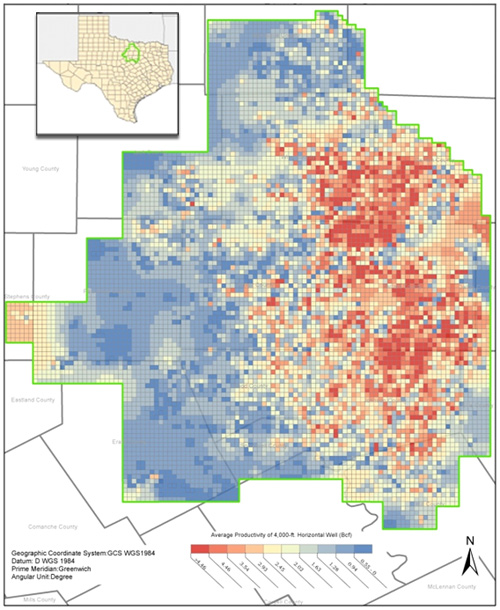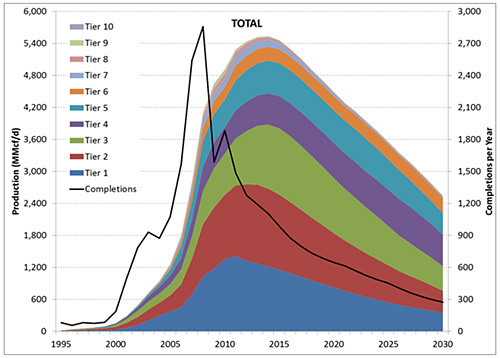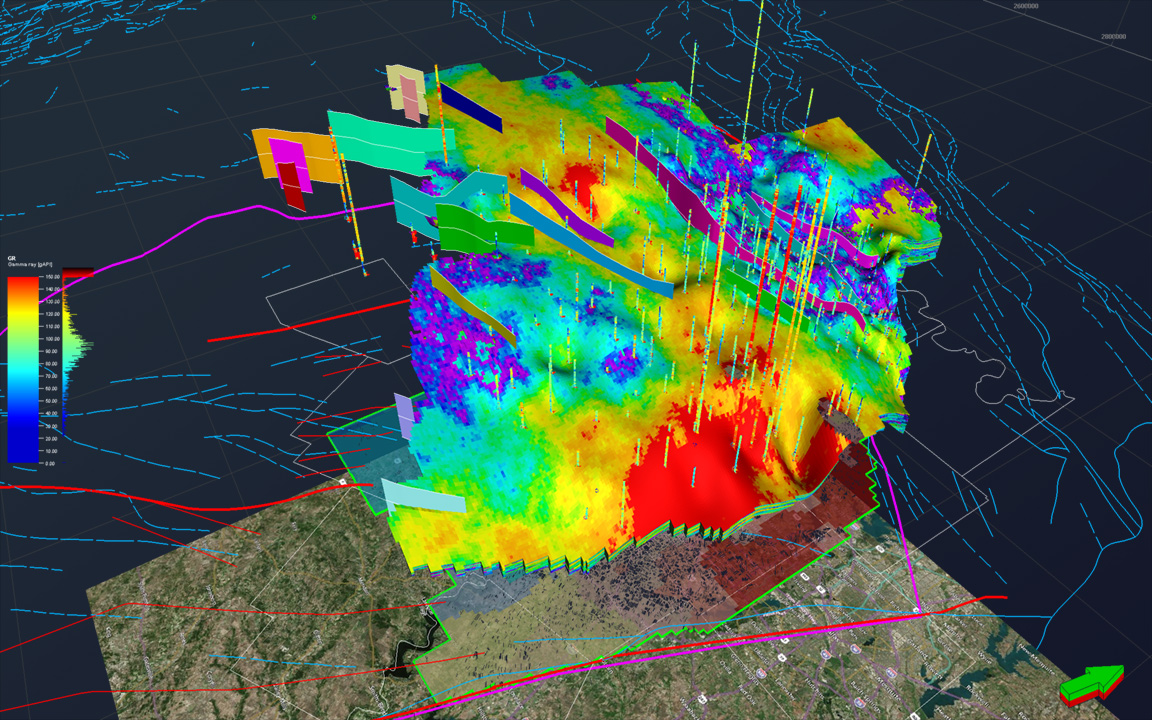Bureau Shale Production and Reserve Study Illuminates U.S. Shale Plays

30-year gas productivity map (Ikonnikova et al., 2013) using assumptions described in Barnett Shale Reserves and Production Forecast: A Bottom-Up Approach (from Browning et al., 2013). County and State Vector Data were acquired from the Texas Natural Resource Information System (TNRIS). Well data provided by IHS and Drillinginfo; well raster logs provided by MJ systems.
The “Shale Revolution” in the United States reinvigorated the American petroleum industry and reshaped world energy markets. Building on the determination and technological experimentation of pioneer George Mitchell and other explorationists, the U.S. energy industry gained the ability to tap into the vast natural gas and oil resources abundant in the country’s petroleum source rocks. Development of shale plays throughout the country combined improved hydraulic fracturing technology with horizontal well drilling and geosteering, resulting in massive new reserves of hydrocarbons. Largely as a result of this success and subsequent oversupply, natural gas prices, and later oil prices, became depressed and exploration slowed. Yet even as drilling slowed, aggregate production increased for many years as operators became even more creative and efficient in well completions and shale characterization.
Some questions, however, are still unresolved and frequently raised: How much resource is still available? What technologies and development strategies would help address the unique geologic and engineering challenges of the individual shale plays? How would production progress under various economic scenarios?
The Bureau of Economic Geology’s multidisciplinary and fully integrated Shale Production and Reserve Study team was designed to answer such questions. With original funding from the Alfred P. Sloan Foundation, the shale study team of geologists, engineers, statisticians, and economists has spent almost 6 years analyzing the major U.S. shale plays. The team’s comprehensive array of publications and presentations has informed the world’s understanding of the production potential of shale plays and further industry developments. Their work is now widely considered to be the most granular and comprehensive publically available research on the subject.
Overseen by Bureau director Scott W. Tinker and led by co–principal investigator Svetlana Ikonnikova and lead engineer John Browning, the study team initially assessed the natural gas–producing Barnett, Fayetteville, Haynesville and Marcellus shale plays, followed by research on the oil-bearing Eagle Ford and Bakken plays. For each shale play, the study team integrates detailed geologic and engineering analysis and economic insights to build a simulation model capable of generating production scenarios. The model enables projection of original hydrocarbons-in-place, remaining recoverable resource, total estimated ultimate recovery, potential future-drilling activity, and production outlook. These findings are dependent on commodity prices, operational costs, technological advances, and regulation.

Base-case production by tier and number of oil wells completed by year (from Browning et al.)
The study team identifies areas where future drilling is likely to occur, when and under what economic conditions drilling should occur, the most likely drilling and production profile, and the economic reserve additions that should result. Unlike other studies of U.S. shale production, the team bases its scenarios on well-by-well analyses rather than on area averaging, analyzing production histories and completion of over 60,000 individual wells across U.S. plays. The Bureau’s research group has developed a sophisticated, integrated workflow process where the geologic, engineering, and economics findings build upon and are interdependent on each other. Frequent team meetings lead to the free exchange of new ideas and innovative concepts that shape the research, and input from select operators in specific areas helps guide and ground the analysis.
The team now invites industry participation as it launches a U.S. Department of Energy (DOE)–supported effort to update each of the shale gas basins. A parallel industry-supported effort, the Tight Oil Resource Assessment (TORA) project, will more fully examine the complexities of the multiple formations of the Midland and Delaware Basins in West Texas.
Currently, published findings indicate that, even at lower prices, significant recoverable reserves in these shale plays could impact global oil and gas production for decades to come. The shale study team continues to evolve and will delve into the myriad questions that remain about the immense production potential of America’s shale plays. The team is responding to international queries regarding shale potential and looks forward to working with governments and industry to expand understanding of global shale.
For more information about the Bureau of Economic Geology’s Shale Production and Reserve Study, or to become a partner in the new Shale Gas Update or Permian Basin TORA projects, please contact External and Governmental Affairs officer Mark W. Blount or log onto https://www.beg.utexas.edu/research/programs/shale.

3D model of the Barnett Shale showing density, porosity, and fault planes. Below the model is a present-day surface image with horizontal well traces represented by thin black lines. Image courtesy of Robin Dommisse, U.S. Shale Production and Reserve Study team.
Project Summary
Project name: U.S. Shale Production and Reserve Study
Principal information contact: Mark W. Blount
Research Program: U.S. Shale Production and Reserve Study; Tight Oil Resource Assessment (TORA)
Project start date: 2010
Project PI(s): Scott W. Tinker, Svetlana Ikonnikova and Mark Walsh
Key research personnel: John Browning (petroleum engineer) and a multi-unit team of geologists, engineers, economists and statisticians
Key technologies employed in this research: Well-by-well analyses; Integrated workflow process; Well and basin economics; Simulation model capable of generating infinite production scenarios
Funding sources and collaborators: Alfred P. Sloan Foundation, U.S. Department of Energy; Multiple shale play operators (collaborators)
Geographic areas of study: Barnett, Fayetteville, Haynesville, Marcellus, Bakken, Eagle Ford, Midland Basin and Delaware Basin shale plays
Keywords: shale; shale play; hydraulic fracturing; fracking; tight oil; shale gas; horizontal drilling
Related publications and information resources: https://www.beg.utexas.edu/research/programs/shale